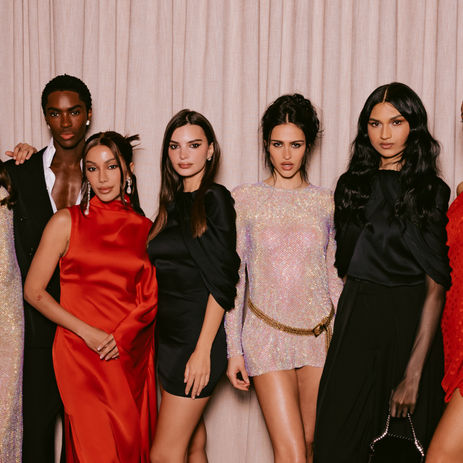Stars, Sneakers, and Spicy Wings: How Press Tours Have Changed
- BY MUFARO MHARIWA

- Sep 1
- 4 min read

For decades, the movie press tour followed a predictable rhythm: red carpet premiere, a round of hotel junket interviews, and a few late-night talk show appearances. It worked because audiences were tuned into the same channels.
But audiences don’t consume media in the same way anymore. The late-night monologue doesn’t trend on X the way a 30-second TikTok clip does. The magazine interview doesn’t rack up millions of views like a YouTube video can. Attention has shifted, and with it, the strategy.
Studios and PR teams are realising they can’t rely on the old formula. If the goal is to sell tickets, the marketing has to meet audiences where they are: scrolling Instagram, bingeing YouTube, or swiping through TikTok. What matters now isn’t just visibility but virality. Stars don’t just need to appear, they need to create authentic, funny, or surprising moments that travel.
This is why the traditional press tour started feeling outdated. A scripted anecdote on late-night TV looks bland next to a raw, unguarded moment captured online. The new press tour is built for an audience that values clips over columns, and memes over monologues.
Amelia Dimoldenberg’s Chicken Shop Date

Few people symbolise the reboot of the press tour better than Amelia Dimoldenberg. What began as a quirky YouTube series filmed in fried chicken shops around London has become a cultural phenomenon, and an unlikely stop on the movie promo circuit.
Her interviews are awkward on purpose. She leans into long silences, deadpan humour, and disarming questions that throw even the most media-trained celebrity off script. For stars, it’s a chance to break free from the polished answers they’ve already given a hundred times at junkets. For audiences, it feels fresh, funny, and shareable.
The results speak for themselves. When Chicken Shop Date clips go viral, so do the actors featured. From Paul Mescal nervously fumbling his way through small talk to Keke Palmer delivering meme-worthy one-liners, the format consistently produces moments that travel across TikTok, Instagram, and Twitter.
Amelia has gone from underground YouTube creator to a red-carpet fixture. She now interviews A-list names at major premieres, often producing more online buzz than traditional entertainment journalists. For PR teams, booking their talent on Chicken Shop Date isn’t a gamble, it’s a guaranteed way to capture the internet’s attention.
Sean Evans and Hot Ones

If Chicken Shop Date is about awkward humour, Hot Ones is about breaking down barriers, quite literally, with hot sauce. Hosted by Sean Evans, the YouTube series flips the traditional celebrity interview on its head by adding a line-up of increasingly spicy chicken wings. What starts as light banter quickly turns into sweat, tears, and unfiltered honesty.
The brilliance of Hot Ones lies in its simplicity. By the time a star has reached sauce number eight or nine, their PR-approved talking points have long evaporated. What’s left is raw vulnerability, the kind of authenticity audiences crave. It’s where major actors confess their fears, share behind-the-scenes stories, and show personality in a way that a late-night talk show couch simply can’t replicate.
Studios have clocked onto this. Plugging a blockbuster on Hot Ones guarantees millions of views and, more importantly, viral moments. Paul Rudd’s now-iconic “Look at us” moment became meme history. Millie Bobby Brown powered through her sauces while promoting Enola Holmes, generating countless clips that travelled far beyond the show’s subscriber base.
For Evans, what started as a niche concept has grown into a marketing juggernaut. For Hollywood, it’s a dream stop on the new-age press tour; one that blends humour, humanisation, and huge online reach.
Sneaker Shopping with Complex

Every sneaker tells a story. Everyone has a pair they grew up with, loved, or just can’t stop thinking about. That’s the unique appeal of Sneaker Shopping with Complex: it gives stars the chance to share personal stories, childhood memories, and sides of themselves that audiences haven’t seen on red carpets or in interviews.
Beyond nostalgia, it’s a rare glimpse into what celebrities actually like to wear when they’re off-set: their casual style, their tastes, their quirks. And while the conversations often drift into their film projects, the real magic is the relatability. Seeing a star reminisce about their first Jordans or explain why they can’t resist a certain sneaker makes them feel human, approachable, and connected to fans in a way that traditional press tours rarely achieve.
Press Tours, Reimagined
Press tours aren’t what they used to be, and that’s a good thing. The one-size-fits-all approach: red carpet, TV interviews, a handful of magazine spreads, is being replaced by something bigger, more versatile, and far more engaging.
That’s not to say magazine spreads and TV interviews are going away; they still have their place. But a new market has opened; one where moments that travel beyond a single night, online and mobile, are king. Whether it’s a star sweating through wings on Hot Ones, swapping sneakers on Complex, or chatting with a TikToker on the red carpet, these interactions are shareable, authentic, and culturally resonant.
The rebooted press tour reflects how audiences actually consume content: online, mobile, and in real time. It’s not just about plugging a movie; it’s about giving fans access, sparking conversation, and showing the people behind the characters in ways traditional media don’t usually do. In short, it’s marketing that feels like culture, and culture that spreads like wildfire.




























































